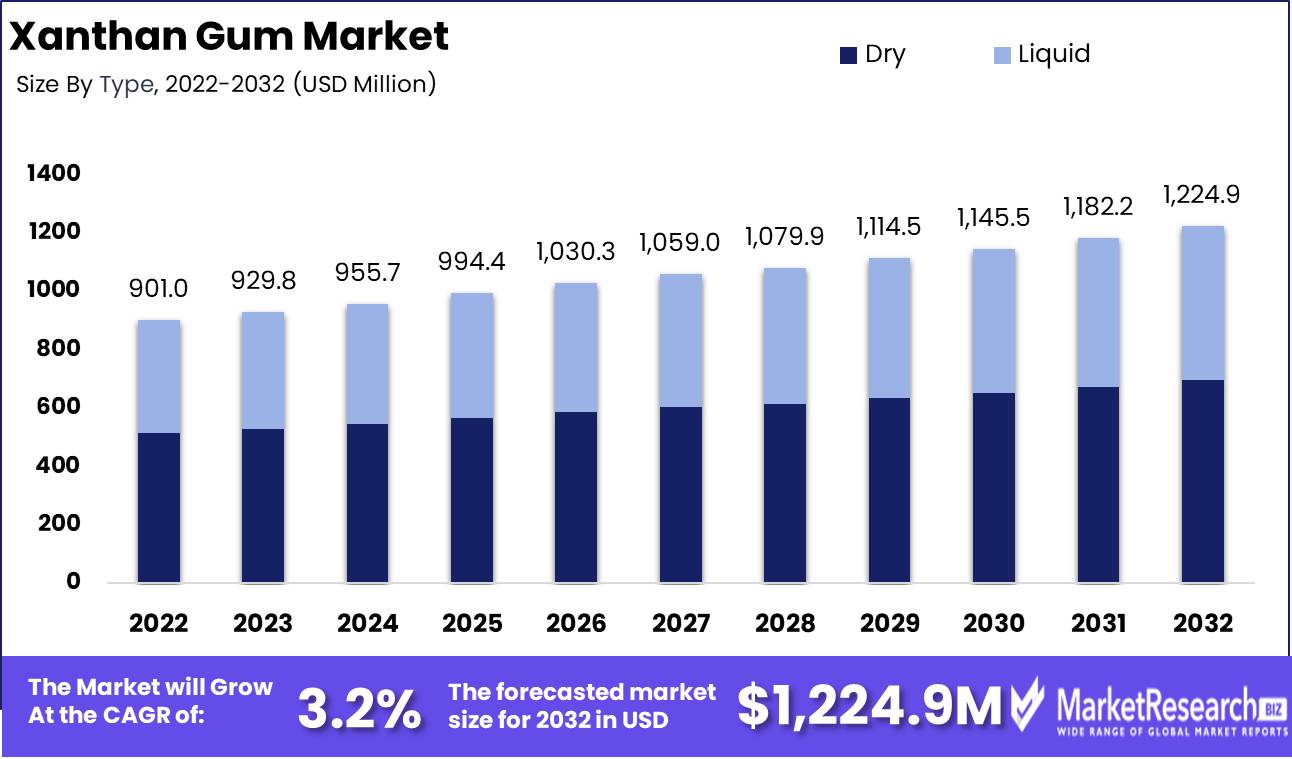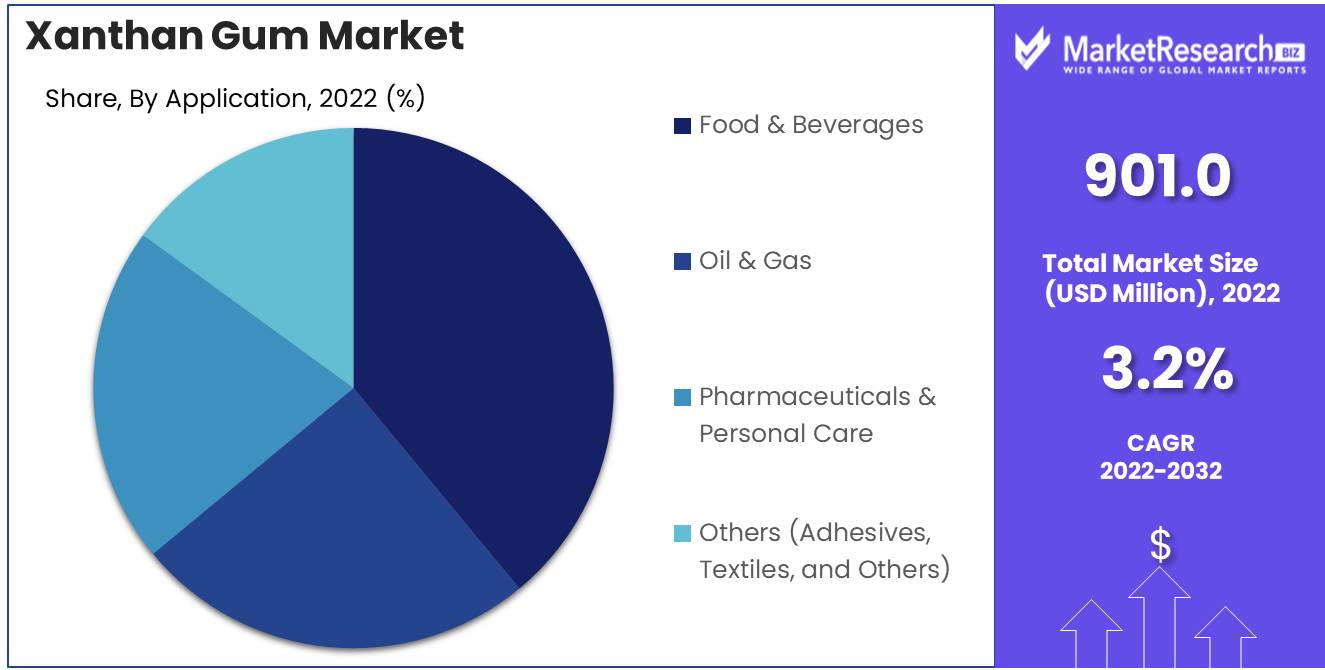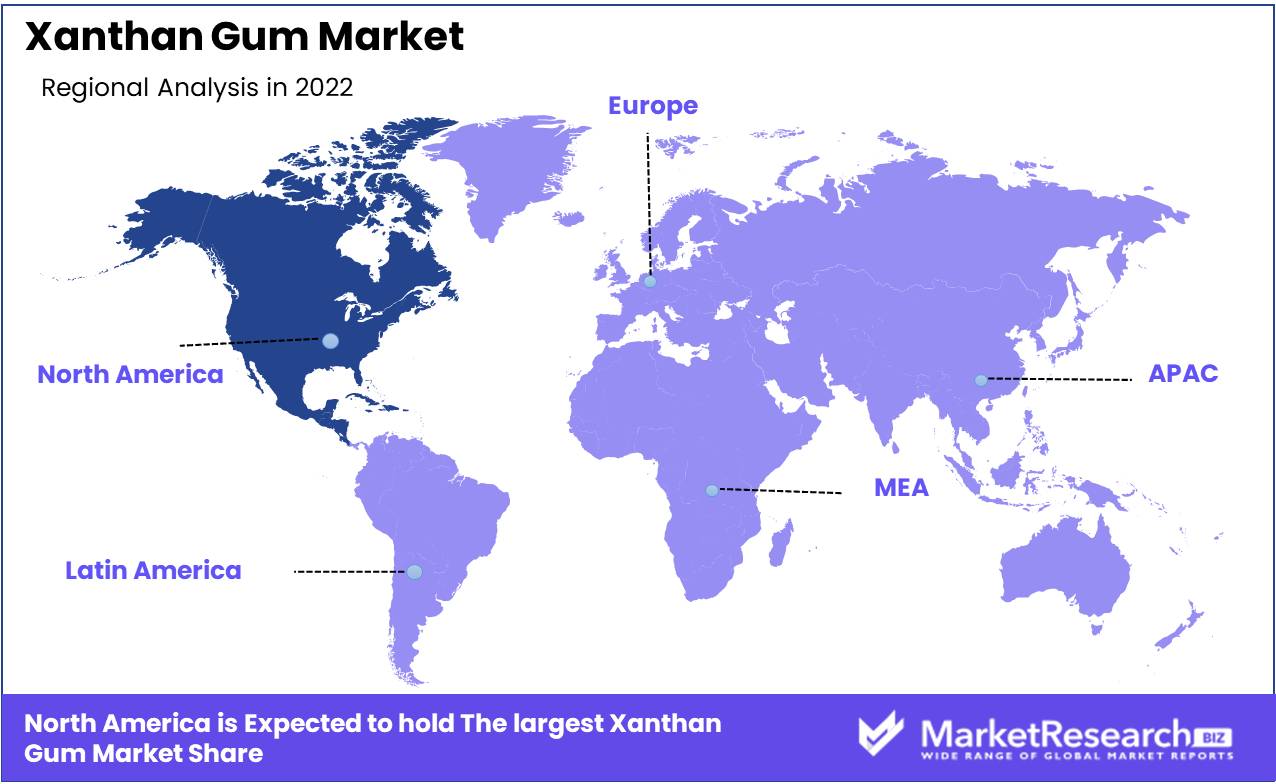
Xanthan Gum Market By Type(Dry, Liquid), By Function(Selling Thickeners, Stabilizers, Gelling Agents, Fat Replacers, Coating Materials, Others), By Application (Food & Beverages, Oil & Gas, Pharmaceuticals & Personal Care, Others (Adhesives, Textiles, and Others)), By Region And Companies - Industry Segment Outlook, Market Assessment, Competition Scenario, Trends, And Forecast 2023-2032
-
40695
-
Jul 2023
-
153
-
-
This report was compiled by Shreyas Rokade Shreyas Rokade is a seasoned Research Analyst with CMFE, bringing extensive expertise in market research and consulting, with a strong background in Chemical Engineering. Correspondence Team Lead-CMFE Linkedin | Detailed Market research Methodology Our methodology involves a mix of primary research, including interviews with leading mental health experts, and secondary research from reputable medical journals and databases. View Detailed Methodology Page
-
Quick Navigation
Report Overview
Xanthan Gum Market size is expected to be worth around USD 1,224.9 Mn by 2032 from USD 901.0 Mn in 2022, growing at a CAGR of 3.2% during the forecast period from 2023 to 2032.
The xanthan gum industry is an incredibly dynamic and multifaceted field within the larger context of the food and beverage industry. In this report, we aim to provide a comprehensive overview of the various key drivers and innovations that have contributed to its meteoric growth in recent years. By delving into the many industries that have invested in xanthan gum and exploring ethical concerns and business applications, we will offer readers a more in-depth understanding of this exciting industry.

Derived from the fermentation of carbohydrates, such as corn, soy, and wheat, xanthan gum is a polysaccharide that takes the form of a colorless or yellowish powder. Its unique properties make it an ideal ingredient for thickening and stabilizing a wide range of food and beverage products, as well as industrial use in adhesives, coatings, and other applications. With its molecular structure, xanthan gum is able to dissolve effortlessly in water and produce a gel-like substance that can help enhance the texture, stability, and viscosity of processed foods.
One of the key factors driving the growing importance of xanthan gum is its versatility across multiple industries. Its gel, thickening, and stabilizing capabilities have made it an extremely popular choice in the food, beverage, and pharmaceutical sectors. Furthermore, its use as a gluten-free ingredient is essential for those with celiac disease or gluten sensitivities, providing a tasty alternative across a broad range of products.
However, it is not just the food and beverage industry that has embraced xanthan gum. Innovations in the oil and gas industries have also resulted in its expanded use as a more efficient drilling method and for enhancing oil recovery. Additionally, the personal care industry has also begun using xanthan gum as a thickening agent in creams and gels.
Driving factors
Gluten-Free Products
The growing demand for gluten-free products is one of the most important factors that drive the xanthan gum market. The manufacturing of gluten-free products, such as baked pastries, sauces, and dressings, requires xanthan gum as an essential ingredient. As awareness of celiac disease and gluten sensitivity increases, consumers increasingly seek gluten-free alternatives. Xanthan gum imparts a distinctive texture and stability to gluten-free products, making it an ideal replacement for wheat flour, which is traditionally used in a variety of foods. In the coming years, the development of the xanthan gum market is expected to be driven by the gluten-free product segment.
Commercial Applications
The unique properties of xanthan gum have also made it a prominent component in industrial applications. In the oil and gas industry, it is commonly used in adhesives, varnishes, and drilling fluids. In these applications, xanthan gum provides viscosity and suspension, making it an important component of drilling muds and cementing operations. Personal care products, such as conditioners and moisturizers, utilize xanthan gum as a thickening agent. In the future, the expanding use of xanthan gum in industrial applications is expected to drive market growth.
Utilisation Expanding in the Food and Beverage Industry
The food and beverage industry is the largest consumer of xanthan gum, accounting for a substantial portion of the market. The unique properties of xanthan gum, such as its ability to form a gel-like substance that thickens and stabilizes products, have made it an ideal additive for a wide variety of food and beverage products. Xanthan gum is commonly used to enhance the texture and stability of condiments, sauces, and beverages. Additionally, xanthan gum is used as a fat substitute, which serves to reduce the fat content of processed goods without altering their texture or flavour. The food and beverage industry's continued expansion is expected to drive the xanthan gum market even higher.
Initiatives in the Field of Research and Development
Extensive research and development initiatives aimed at enhancing its properties and discovering new applications have benefited the xanthan gum market. Consequently, xanthan gum is increasingly utilized in pharmaceutical and medical applications, such as controlled drug delivery and wound dressings. In addition, researchers are investigating the use of xanthan gum in tissue engineering, where it can be utilized as a scaffolding material to promote cell growth. As additional research is conducted on the potential applications of xanthan gum, the market is expected to expand.
Restraining Factors
Limited raw material availability
Xanthan gum is generated by fermenting carbohydrates derived from maize, soy, wheat, and dairy products, among others. Due to weather conditions, crop yields, and other factors that influence their availability and quality, procuring these raw materials can be difficult. For example, extreme weather conditions such as droughts or floods can have a significant impact on agricultural yields, potentially disrupting the supply chain for xanthan gum manufacturers.
Strict quality control standards
Xanthan gum must adhere to stringent quality control regulations mandated by various governments and trade associations. These regulations ensure that the product is secure for human consumption, free of contaminants, and labeled appropriately. To comply with these regulations, manufacturers must invest in quality control measures such as testing equipment, staff training, and certifications. Failure to comply may result in legal penalties, product recalls, and market credibility loss.
Limited storage life
The short expiration life of xanthan gum may impact its logistics and supply chain management. The product may benefit from proper storage conditions, such as temperature control or protective packaging, to ensure that it remains fresh and of high quality until it reaches the end user. In addition, manufacturers must balance production with demand in order to minimize product loss or waste due to expired inventory.
Type Analysis
Xanthan gum is an extensively used food thickener that has established a significant market presence worldwide. It is noteworthy to note, however, that the Dry Segment of xanthan gum has been dominating the market over time.
The Dry Segment of xanthan gum is a granule that is simple to store, utilize, and transport. This segment is manufactured by dehydrating fermented xanthan gum. The Dry Segment has acquired popularity in the food industry as a result of its simple storage and handling characteristics. In a variety of culinary and beverage products, it serves as a thickener, stabiliser, and emulsifier.
The primary factor driving the adoption of xanthan gum in emerging economies is economic development. The expansion of the culinary industry in these markets has had a significant impact on the demand for xanthan gum. As disposable income and purchasing power rise, consumers demand food items that are thickened, emulsified, and stabilised with xanthan gum.
Consumers are always searching for convenience in food products. This is exactly what the Dry Segment of xanthan gum provides. Consumers favour products that are simple to store, transport, and employ. The Dry Segment provides these properties and is therefore the segment of xanthan gum that consumers prefer.
Function Analysis
The Selling Thickeners Segment has emerged as a dominant participant in the xanthan gum market, offering functionality beyond that of a culinary thickener.
The Selling Thickeners Segment is an enhanced form of xanthan gum with widespread industrial applications. It is predominantly used as a thickener, but its viscosity and suspension properties allow it to be used in a wide range of applications, including petroleum, pharmaceuticals, textiles, and personal care products.
The economic development of emerging societies drives the use of xanthan gum in a variety of industries. Demand for sophisticated varieties of xanthan gum, such as the Selling Thickeners Segment, has increased due to the expansion of these industries. Increasing demand for xanthan gum is attributable to the expansion of the oil and gas industry, pharmaceuticals, and personal care industries.
Consumers are increasingly interested in products that provide advantages beyond their principal function. In the case of xanthan gum, the Selling Thickeners Segment offers a number of additional functional advantages beyond thickening.
Application Analysis
Due to xanthan gum's adaptability, the Food and Beverages Segment has become the dominant market for its use.
In the food and beverage industry, xanthan gum is commonly used as a thickener, stabilizer, and emulsifier. Its properties facilitate its use in a wide range of culinary and beverage products, including sauces, bakery goods, and beverages.
The expansion of the food and beverage industry in emerging nations has contributed considerably to the rise in xanthan gum demand. As disposable income and purchasing power increase, consumers are demanding healthy and flavorful food products of superior quality. The properties of xanthan gum allow it to be used in a variety of culinary and beverage products, catering to the diverse requirements and preferences of consumers.
Increasingly health-conscious consumers are demanding food and beverage products that are nutritious, healthy, and tailored to their dietary requirements. As a plant-based substance, xanthan gum is considered a healthful and natural alternative to synthetic thickeners and stabilizers.

Key Market Segments
Based on Type:
- Dry
- Liquid
Based on Function:
- Selling Thickeners
- Stabilizers
- Gelling Agents
- Fat Replacers
- Coating Materials
- Others
Based on Application:
- Food & Beverages
- Oil & Gas
- Pharmaceuticals & Personal Care
- Others (Adhesives, Textiles, and Others)
Growth Opportunity
Geographical Expansion into New Regions
As the demand for xanthan gum continues to grow, it is essential to expand into new geographical regions. Due to rising demand in the food and beverage industry, the Asia-Pacific region is expected to experience significant growth. In addition, the Middle East and Africa offer opportunities for xanthan gum manufacturers to expand their market presence.
Application diversification
In addition to the food and beverage industry, xanthan gum is in high demand in several other industries, including pharmaceuticals, cosmetics, and personal care, among others. Consequently, a significant opportunity for xanthan gum manufacturers to expand their business is diversification into new applications.
Increasing Capacity for Production
In the future years, the demand for xanthan gum is expected to grow exponentially, necessitating an increase in production capacity for manufacturers. With advancements in technology and production methods, it is now possible to produce xanthan gum on a large scale, making it both cost-effective and efficient.
Penetration of New Client Segments
There is a significant demand for xanthan gum in the food and beverage industry, but there are also opportunities in a number of other industries. Targeting new consumer segments, such as those in the pharmaceuticals and cosmetics industries, can help manufacturers enter new markets and increase their customer base.
Development of Novel Product Formulations
To satisfy the changing demands of consumers in the xanthan gum market, product formulation innovation is essential. Manufacturers can create new and improved xanthan gum products that offer better quality and efficacy, making them more alluring to consumers, thanks to advancements in xanthan gum technology and research.
Strategic Alliances with Key Participants
Strategic alliances with major xanthan gum market players can offer a number of advantages, including increased brand recognition, access to new markets, and collaborations on research and development. Collaboration with key players can provide xanthan gum manufacturers with a significant opportunity to expand their market presence and grow their business.
Latest Trends
Strategic Alliances
The xanthan gum market has experienced a significant growth surge as a result of strategic alliances between key players. The concentration of the collaborations has been on creating innovative and cost-effective products to meet the ever-changing consumer demand. In addition, the partnerships seek to enhance the production of xanthan gum, improve its quality, and assure regulatory compliance. The partnerships have produced significant results by accelerating market growth and enabling key players to improve their product portfolios, expand their market presence, and increase their brand recognition.
Research and development funding
Research and development (R&D) has emerged as a significant trend influencing the xanthan gum market. To develop new products and improve the quality of existing ones, major players are investing extensively in research and development. The focus of R&D is on enhancing xanthan gum's functionality, enhancing its quality, and making it more cost-effective. The investments in R&D have resulted in the creation of new products that satisfy the ever-changing consumer demand, significantly contributing to the market's growth.
Investigation of New Distribution Channels
In the xanthan gum market, the emergence of new distribution channels has emerged as a key trend. To expand their market presence and increase their market share, major players are exploring new distribution channels. Collaborations with distributors have ensured the market availability of products in various regions, and marketing and advertising initiatives have increased consumer awareness. Not only have the new distribution channels increased the availability of xanthan gum, but they have also enabled manufacturers to reach new consumers and enhance brand recognition.
Increasing Brand Awareness
The growth of the xanthan gum market is being driven by a crucial development in brand recognition. Manufacturers are investing in marketing and advertising to improve the visibility of their brands and reach more consumers. To increase product awareness, they are utilizing various marketing strategies, including online marketing, social media, and print media. The investments in marketing have effectively enhanced the brand recognition of key market players, contributing to the growth of the market.
Increasing Supply Chain Productivity
Improving supply chain effectiveness has emerged as a significant trend influencing the xanthan gum market. Manufacturers are investing in technology and equipment in order to optimize their production processes, reduce production costs, and increase productivity. In addition, enhancements in logistics and transportation processes ensure that consumers receive their products on time. Such investments have substantially improved the delivery of xanthan gum, reduced costs, and enhanced efficiency, thereby contributing to the growth of the market.
Regional Analysis
Xanthan gum is a polysaccharide utilized as a food thickener, stabilizer, and emulsifier. It offers numerous benefits, such as improved texture, increased shelf life, and enhanced viscosity. Due to its distinctive properties, it is utilized in numerous industries, including the food and beverage, oil and gas, pharmaceutical, and personal care sectors.
Due to the increasing demand for processed foods and the expansion of the oil and gas industry, we anticipate that North America will be the largest xanthan gum market. The United States is the leading contributor to the expansion of the regional xanthan gum market. Due to the presence of numerous xanthan gum manufacturers and the increasing demand for processed foods, the country claims the largest share of the market.
In addition, the North American oil and gas industry is anticipated to contribute to the growth of the xanthan gum market. In the oil and gas industry, xanthan gum is commonly used as a drilling fluid additive. It offers numerous advantages, such as enhanced fluid loss control, enhanced suspension properties, and enhanced wellbore stability.
In addition, the rising demand for gluten-free products is anticipated to contribute to the expansion of the xanthan gum market in North America. In gluten-free products, xanthan gum is commonly used as a binder and emulsifier to provide texture and stability.

Key Regions and Countries
North America
- US
- Canada
- Mexico
Western Europe
- Germany
- France
- The UK
- Spain
- Italy
- Portugal
- Ireland
- Austria
- Switzerland
- Benelux
- Nordic
- Rest of Western Europe
Eastern Europe
- Russia
- Poland
- The Czech Republic
- Greece
- Rest of Eastern Europe
APAC
- China
- Japan
- South Korea
- India
- Australia & New Zealand
- Indonesia
- Malaysia
- Philippines
- Singapore
- Thailand
- Vietnam
- Rest of APAC
Latin America
- Brazil
- Colombia
- Chile
- Argentina
- Costa Rica
- Rest of Latin America
Middle East & Africa
- Algeria
- Egypt
- Israel
- Kuwait
- Nigeria
- Saudi Arabia
- South Africa
- Turkey
- United Arab Emirates
- Rest of MEA
Key Players Analysis
Xanthan gum, an exceptionally well-known hydrocolloid, is a highly versatile substance that finds application as a thickener, stabilizer, and emulsifier in a myriad of industries ranging from food and beverages to personal care and pharmaceuticals. This highly potent hydrocolloid is obtained through the fermentation of various sugars and is renowned for its remarkable ability to hold water, shear-thinning behavior, and pseudo-plasticity.
The global xanthan gum market is on the cusp of a dramatic upswing, with industry experts predicting a significant surge in demand for this substance in the coming years. This growth is primarily attributed to the ever-increasing demand for convenience foods, coupled with the burgeoning prevalence of gluten intolerance. Moreover, the use of xanthan gum as a more efficient and sustainable substitute for animal-based thickeners has also contributed significantly to the rise in demand for this highly functional hydrocolloid.
A vast number of well-known companies operate within the xanthan gum market, with industry giants such as Cargill, Meihua Group, Archer Daniels Midland Company, and Jungbunzlauer Suisse AG leading the pack. These corporations offer an extensive range of xanthan gum products, featuring varying properties and grades that cater to the diverse needs of end-users. To stay ahead of the curve, these companies are pouring considerable investments into research and development initiatives aimed at developing novel xanthan gum formulations that can improve the functionality, stability, and sensory attributes of various products.
Top Key Players in Xanthan Gum Market
- Cargill
- DowDuPont Inc.
- Ingredion Incorporated
- Archer Daniels Midland Company
- Solvay
- Fufeng Group Company Ltd.
- Cp Kelco
- Jungbunzlauer Suisse AG
- Deosen Biochemical Ltd.
- Fuerst Day Lawson
Recent Development
In July 2022, CP Kelco announced a significant expansion of its bio-gum production capacity, targeting the xanthan gum market in particular. This expansion involves the company's facilities in both the United States and China in an effort to satisfy the rising demand for this versatile hydrocolloid.
In October 2021, CP Kelco entered into a partnership with Azelis to expand its distribution network in the Australian and New Zealand markets. Azelis is now able to offer Kelco's Consumer & Industrial (C&I) and Food Applications constituents, including the highly sought-after Keltrol Xanthan Gum.
In September 2021, Tilley Company effectively acquired Ingredients Solutions Inc., a leading distributor of hydrocolloids, including xanthan gum. This acquisition strengthens Tilley Company's position in the xanthan gum market and enables the company's sustained expansion.
Report Scope:
Report Features Description Market Value (2022) USD 901.0 Mn Forecast Revenue (2032) USD 1,224.9 Mn CAGR (2023-2032) 3.2% Base Year for Estimation 2022 Historic Period 2016-2022 Forecast Period 2023-2032 Report Coverage Revenue Forecast, Market Dynamics, COVID-19 Impact, Competitive Landscape, Recent Developments Segments Covered By Type(Dry, Liquid), By Function(Selling Thickeners, Stabilizers, Gelling Agents, Fat Replacers, Coating Materials, Others), By Application (Food & Beverages, Oil & Gas, Pharmaceuticals & Personal Care, Others (Adhesives, Textiles, and Others) Regional Analysis North America – The US, Canada, & Mexico; Western Europe – Germany, France, The UK, Spain, Italy, Portugal, Ireland, Austria, Switzerland, Benelux, Nordic, & Rest of Western Europe; Eastern Europe – Russia, Poland, The Czech Republic, Greece, & Rest of Eastern Europe; APAC – China, Japan, South Korea, India, Australia & New Zealand, Indonesia, Malaysia, Philippines, Singapore, Thailand, Vietnam, & Rest of APAC; Latin America – Brazil, Colombia, Chile, Argentina, Costa Rica, & Rest of Latin America; Middle East & Africa – Algeria, Egypt, Israel, Kuwait, Nigeria, Saudi Arabia, South Africa, Turkey, United Arab Emirates, & Rest of MEA Competitive Landscape Cargill, DowDuPont Inc., Ingredion Incorporated, Archer Daniels Midland Company, Solvay, Fufeng Group Company Ltd., Cp Kelco, Jungbunzlauer Suisse AG, Deosen Biochemical Ltd., Fuerst Day Lawson Customization Scope Customization for segments, region/country-level will be provided. Moreover, additional customization can be done based on the requirements. Purchase Options We have three licenses to opt for: Single User License, Multi-User License (Up to 5 Users), Corporate Use License (Unlimited User and Printable PDF) -
-
- Cargill
- DowDuPont Inc.
- Ingredion Incorporated
- Archer Daniels Midland Company
- Solvay
- Fufeng Group Company Ltd.
- Cp Kelco
- Jungbunzlauer Suisse AG
- Deosen Biochemical Ltd.
- Fuerst Day Lawson




